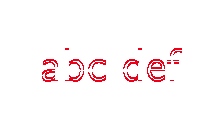samcarter

It is often interesting to know if the output of two different documents (or the same document using different package/kernel versions) is the same.
Which different techniques can be used to test this?
----
Just as an example document for testing:
```
\documentclass{beamer}
\begin{document}
\begin{frame}
\vspace{0.1mm}% test with and without this line
abc def
\end{frame}
\end{document}
```
Top Answer
samcarter

One possible approach is to make a visual diff of the resulting documents.
The following script is rather hacky and has a lot of external dependencies, but maybe it can be used as a starting point.
The main idea is that each page of the documents gets converted into a pixelate image and then the pixel values are compared. If they differ, they are highlighted in red.
### Usage
It can be executed with
```
lua pdfdiv.lua "document_old" "document_new"
```
and will produce an image `diff-<page number-1>.png` for every page that has differences
----
```
#!/usr/local/bin/lua
---------------------------------------------------------------------
--
-- making a visual diff of two pdfs
--
---------------------------------------------------------------------
function visual_div(old, new)
-- stripping file ending from name
doc_old = old:match("(.+).pdf") or old
doc_new = new:match("(.+).pdf") or new
-- getting number of pages in each document ---------------------
local handle = io.popen("pdfinfo " .. doc_old .. ".pdf | grep Pages | awk '{print $2}'")
local pages_old = handle:read("*a")
handle:close()
local handle = io.popen("pdfinfo " .. doc_new .. ".pdf | grep Pages | awk '{print $2}'")
local pages_new = handle:read("*a")
handle:close()
---- converting pdf's into png images ---------------------------
os.execute("convert -density 300 " .. doc_old .. ".pdf " .. doc_old .. ".png")
os.execute("convert -density 300 " .. doc_new .. ".pdf " .. doc_new .. ".png")
-- loop over pages ----------------------------------------------
for i = 0, pages_new-1, 1
do
-- check if page exists in old document ---------------------
if( pages_old+0.0 >= i)
then
-- suffix based on number of pages ----------------------
if( pages_old+0.0 == 1.0 )
then
suffix = ""
else
suffix = "-" .. i
end -- check if only one page
-- calculating diff -------------------------------------
os.execute("compare -compose src " .. doc_old .. suffix .. ".png " .. doc_new .. suffix .. ".png diff" .. suffix .. ".png")
-- getting number of changed pixels ---------------------
local handle = io.popen("convert diff" .. suffix .. ".png -print '%[fx:w*h*(1-mean)]' null:")
local diff_pixel = handle:read("*a")
handle:close()
-- clean up ---------------------------------------------
os.execute("rm " .. doc_new .. suffix .. ".png")
os.execute("rm " .. doc_old .. suffix .. ".png")
-- keeping only images with differences -----------------
if(diff_pixel+0.0 > 0.0)
then
-- print(diff_pixel)
else
os.execute("rm diff" .. suffix .. ".png")
end
end -- check if page exist
end -- loop over pages
end -- end function
---------------------------------------------------------------------
--
-- calling function
--
---------------------------------------------------------------------
-- e.g. lua pdfdiv.lua "document_old" "document_new"
visual_div(arg[1], arg[2])
```
### Dependencies:
- `convert` and `compare` from the `ImageMagick` library
- pdfinfo
- grep
- awk
- whatever I forgot in the list above
### Disadvantages:
- slow (I really mean it, don't try with a very long document)
### Advantages:
- will not only show that something has changed, but provide visual context of what has changed. This way the user can for example judge if they mind that a word is 1 mm further down or not
- will sort out which pages actually do have changes, so no need to check all of them
### Output from the test document:

Answer #2
samcarter

Ulrike Fischer made me aware of the `pdfpagediff` package
```
\documentclass{article}
\usepackage{pdfpagediff}
\begin{document}
\layerPages{document.pdf}{document2.pdf}
\end{document}
```
This will produce a new document with the two previous ones overlayed. If you have adobe reader, you can use the `layers` menu at the left hand site to toogle between the documents to see if there are any significant changes.
### Caveats:
- If you have a document with opaque background (like beamer), you will only be able to see one layer at a time instead of both overlayed (but you will still be able to toggle between them)
- only works with pdfTeX